If you’ve ever tried spirulina powder, my bet is that you never want to taste it again. It’s not pleasant, and yet, it’s been consumed for centuries by the natives living around lake Chad in Africa and traded as an important commodity between the Aztecs of Central America and Spanish conquistadors [1].
In the few places where this cyanobacteria grows naturally, spirulina has been harvested, eaten, and traded despite tasting like pond water. Why?
Certainly, one reason is because spirulina is an incredibly rich source of protein, vitamins, and minerals, but I think there was something else to it. I’d bet that spirulina was seen as a general health tonic that made people feel good.
After all, several studies have shown that spirulina protects the heart, liver, and intestinal cells from oxidative stress and mitochondrial damage, stimulates mitochondrial biogenesis, and attenuates metabolic dysfunction [2–4].
These benefits are largely due to a little molecule it contains called C-Phycocyanin, which could possibly be the most potent phytochemical in existence through mimicking the structure of bilirubin and having similar physiological effects [5,6].

In this article, I’m going to share with you the incredible benefits of spirulina and explain why it is a true superfood compound. And the best place to start is by explaining why it’s structural similarity to bilirubin is so important.
Spirulina Could Mimic Gilbert’s Syndrome
In 1901, Augustin Gilbert discovered a liver disorder now known as Gilbert’s Syndrome, in which a genetic mutation reduces the body’s ability to break down a little molecule called bilirubin and consequently causes it to be chronically elevated.
Other than a mild jaundice that can appear during periods of exertion, stress, and fasting, the condition is usually benign and doesn’t require treatment [7]. In fact, people with Gilbert’s syndrome seem to have incredible metabolic health compared to those without:
- A 50% lower risk of death from any cause compared to the general population [8].
- A 60–80% lower risk of heart disease [9–11].
- A 20% lower risk of type 2 diabetes [12].
- Higher antioxidant status and less oxidative stress [13–15].
- Improved blood vessel function [15].
- Longer telomeres [16].
There’s no ambiguity here: bilirubin is protecting those with Gilbert’s syndrome.
Mice genetically altered to mimic Gilbert’s syndrome are resistant to obesity and have higher tissue concentrations of mitochondria [17]. If you take normal mice and feed them an obesogenic diet, supplementing bilirubin reduces the extent of metabolic dysfunction that ultimately develops [18,19].
You see, bilirubin is a potent antioxidant and anti-inflammatory molecule that’s been implicated in the prevention of metabolic syndrome and diabetes, cardiovascular diseases, and kidney disease [20–23].
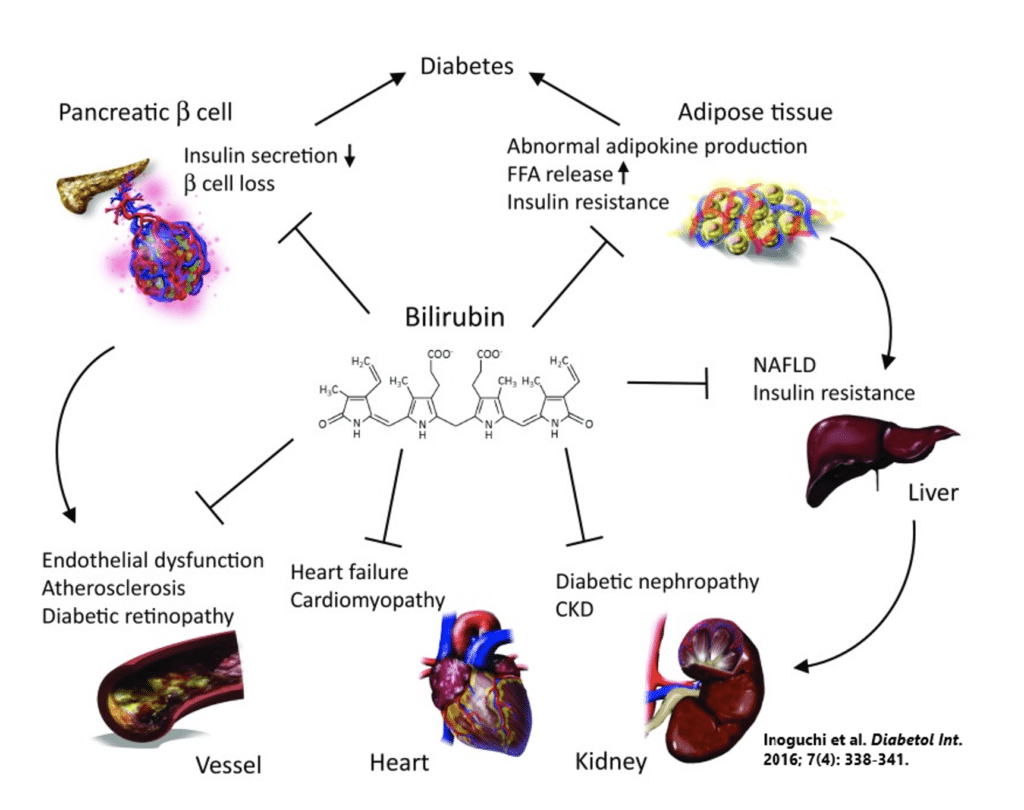
These incredible benefits are due primarily to bilirubin’s ability to inhibit NADPH oxidases [24,25], which are enzymes that create free radicals and contribute to the oxidative stress seen in many disease states [26,27]:
- Fat cells in obesity
- Blood vessels and heart in cardiovascular diseases
- Microglia, astrocytes, and neurons of brain diseases
- Pancreas of diabetes
- Colon of colon cancer
- Liver of fatty liver
- Kidneys of kidney disease
- Bone of osteoporosis
- Retina of macular degeneration
Basically, NADPH oxidases are a fundamental source of oxidative stress and disease, and bilirubin directly binds to and inhibits them, thereby protecting against metabolic dysfunction and a host of other pathologies.
Spirulina’s primary phytochemical mimics bilirubin and spirulina supplementation could therefore bestow many of the benefits of Gilbert’s syndrome.
Spirulina Protects Against Metabolic Dysfunction
We see many of the cardioprotective effects of Gilbert’s Syndrome play out with spirulina supplementation, further supporting a connection between the two. Numerous clinical trials have shown that spirulina supplementation improves metabolic health.
For example, a meta-analysis of 12 studies involving adults with metabolic syndrome found that an average of just 2 grams per day of spirulina significantly lowered fasting glucose, blood pressure, and blood lipids after 2–3 months [28].
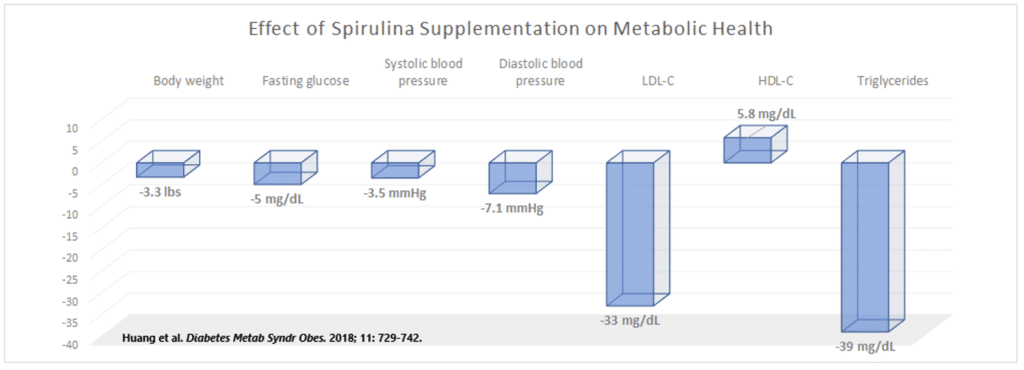
These benefits have profound implications for your long-term health. Based on a meta-analysis of 49 studies looking at the relationship between LDL-C and cardiovascular disease [29], we can expect regular supplementation with spirulina to reduce your risk of having a major event by at least 25%.
Several other systematic reviews and meta-analyses have supported these findings, reporting that spirulina improves glycemic control, alleviates dyslipidemia, and reduces visceral fat in older adults, postmenopausal women, and those with metabolic dysfunction [30–32].
The effects are particularly pronounced if you are someone currently dealing with metabolic dysfunction. For example, in adults with type 2 diabetes, 2 grams of spirulina per day reduced fasting blood glucose by 12%, post-meal glucose by 6%, and HbA1c by 11% after two months [33].
In obese adults with medication-controlled hypertension, supplementing just 2 grams of spirulina per day reduced body weight and blood lipids while increasing total antioxidant status and insulin sensitivity compared to a placebo [34].
In adults with chronic obstructive pulmonary disease, 2–4 grams of spirulina per day improved blood lipids, reduced oxidative stress, and increased antioxidant enzyme activity [35].
Lastly, if you are someone with non-alcoholic fatty liver disease (NAFLD), a condition that currently affects 1 of every 4 adults worldwide and is a common comorbidity of obesity and diabetes [36], then spirulina should be on your supplement shelf. Supplementation with 4–6 grams per day of spirulina for six months has been shown to reduce liver enzymes, liver fat, insulin resistance, and blood lipids [37,38].
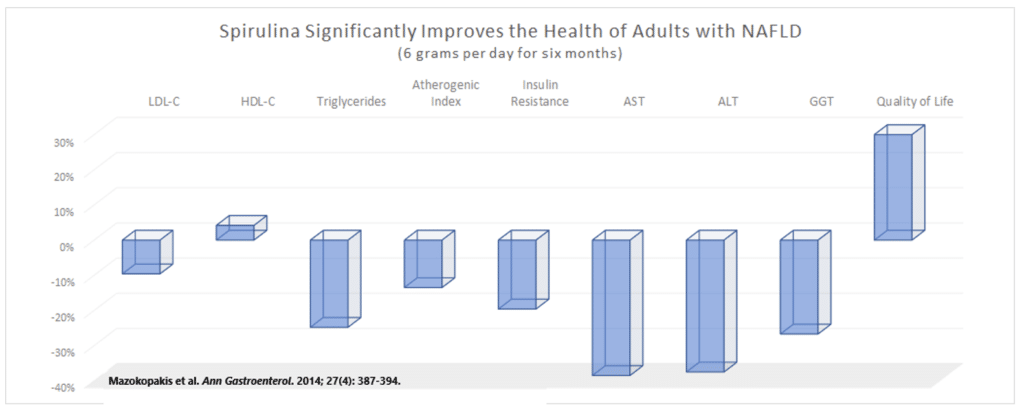
Spirulina Improves Exercise Performance and Reduces Fatigue
On top of improving metabolic health, spirulina has an abundance of evidence showing that it improves endurance exercise performance and reduces fatigue in both recreational athletes and the average joe looking to improve their health through exercise.
In one study, for example, researchers had recreational runners run at a steady state for two hours and then do an all-out sprint for as long as they could handle it [39]. Compared to those taking a placebo, supplementing with 6 grams of spirulina per day for six weeks increased the sprint time until physical exhaustion by 30%, enhanced fat oxidation during the 2-hour run by 10%, increased glutathione concentrations by 23%, and reduced exercise-induced increases in lipid peroxidation by 34%.
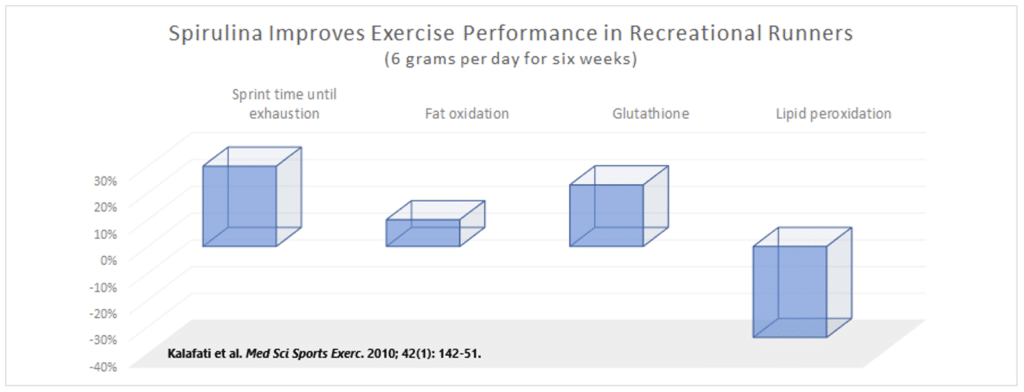
Other studies have reported similar observations. One found that that supplementing with 7.5 grams of spirulina increased the duration that the participants could exercise by 7.3% while reducing markers of oxidative stress [40], and another reported that 3 grams of spirulina taken for 8 weeks reduced physical fatigue during exercise and mental fatigue afterwards [41].
Lastly, one group of researchers wanted to see how spirulina and exercise interact to affect the health of overweight and obese adults, so they divided participants into four groups for 12 weeks [42,43].

They found that, regardless of whether the participants exercised or not, spirulina significantly reduced body weight, reduced blood lipids, and improved cardiorespiratory fitness. That being said, the improvements in cardiorespiratory fitness were most pronounced in those who supplemented alongside their exercise program.
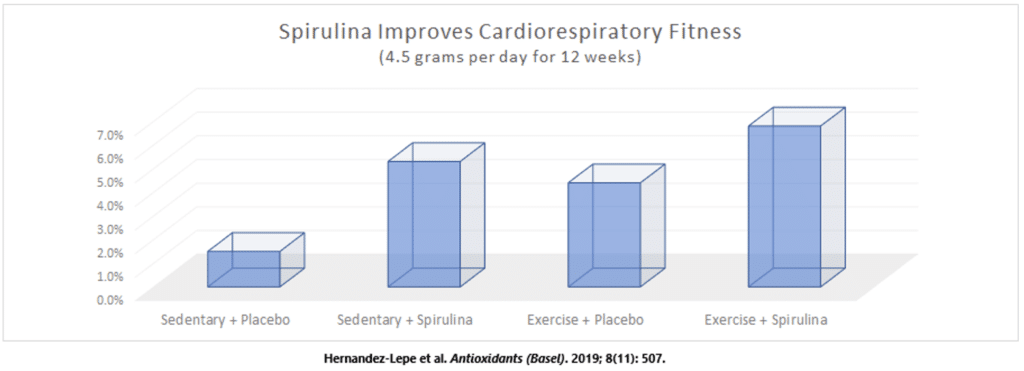
Spirulina Reduces Pain, Allergies, and Heavy Metal Accumulation
I want to end by briefly touching on some other less investigated avenues of potential benefit for spirulina, including how it impacts pain, allergies, and detoxification processes.
In one study using a spirulina extract containing high concentrations of its primary bioactive molecule, phycocyanin, participants with chronic joint pain experienced a significant reduction in pain severity after just two weeks [44].
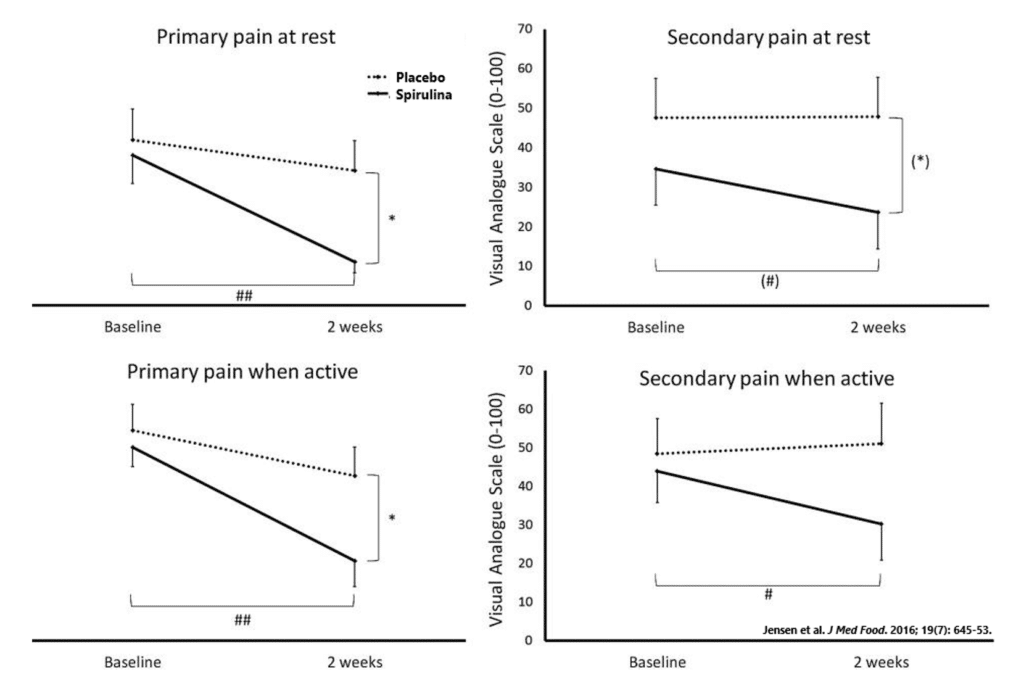
As far as allergies go, one group of researchers recruited adults who suffered from allergic rhinitis and had them supplement with either 2 grams of spirulina or placebo daily over six months [45]. Those fortunate enough to be randomized to the spirulina group experienced a 70–80% reduction in allergy symptoms, which was more than double that of the placebo group. They also reported twice the satisfaction and perceived effectiveness of the intervention.
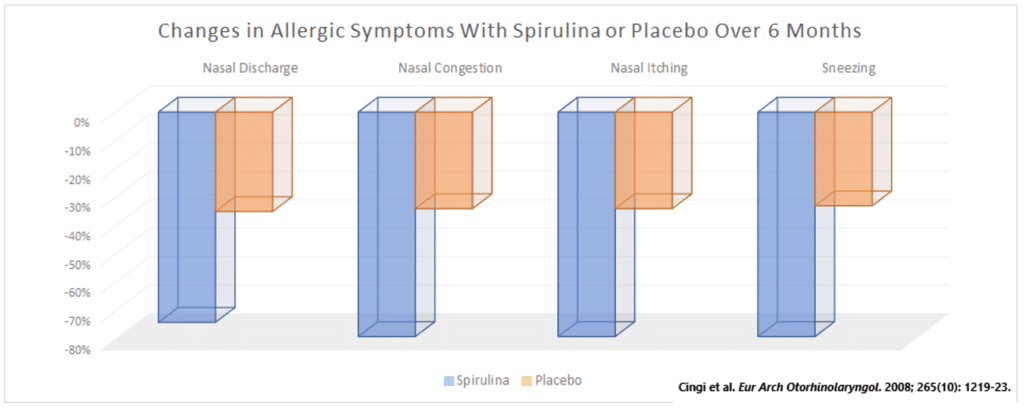
Finally, there’s preliminary evidence that spirulina can help detoxify the body of heavy metals like arsenic in animals [46,47]. In fact, having adults with arsenic poisoning supplement with just 500 mg of spirulina per day is able to reduce their arsenic concentrations by 50% after 16 weeks, compared to minimal change in those taking a placebo [48].
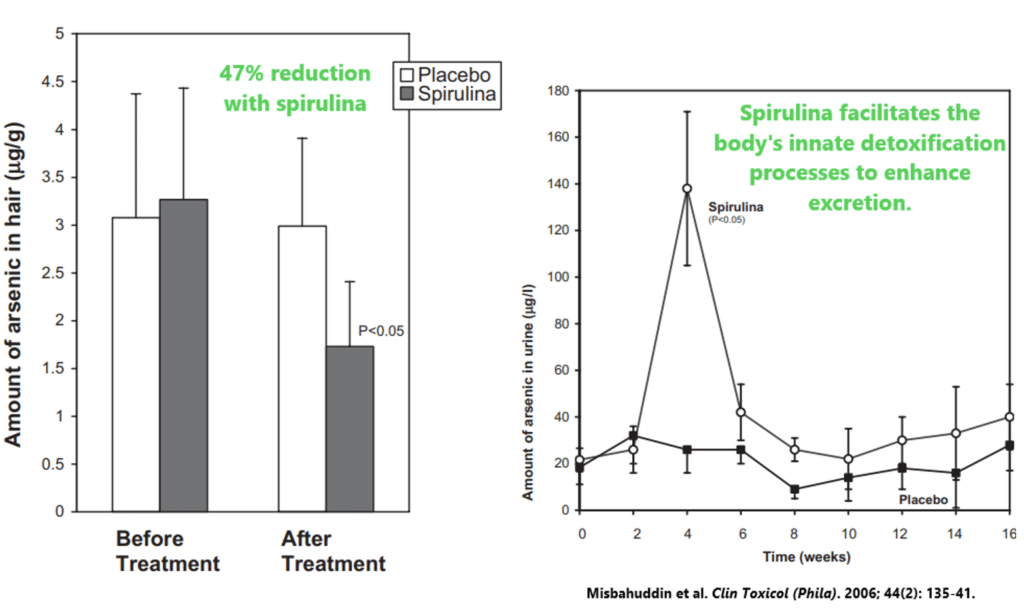
While the precise mechanism isn’t really worked out yet, the spirulina did cause a sharp spike in urinary arsenic secretion, suggesting that it may enhance the body’s own intrinsic ability to remove toxic metals.
Summary
Spirulina is a cyanobacteria possessing one of the most potent phytochemicals in existence: phycocyanin. This molecule is structurally similar to the antioxidant and anti-inflammatory bilirubin that we naturally create, thereby giving spirulina many of the benefits of bilirubin.
These include a reduced risk of death and cardiovascular disease, as evidenced by studies of people with Gilbert’s syndrome, a liver disorder that leads to elevated bilirubin levels. Clinical trials have shown that spirulina supplementation reduces insulin resistance and blood lipids, enhances exercise performance, lessens fatigue, lowers pain, improves allergies, and facilitates heavy metal detoxification.
Overall, the science overwhelmingly shows that spirulina is a true superfood that improves metabolic health, physical function, and vitality. That’s why we’ve made it one of the cornerstone ingredients of our health-boosting multivitamin superfood formula, Energy Essentials and Superfoods.
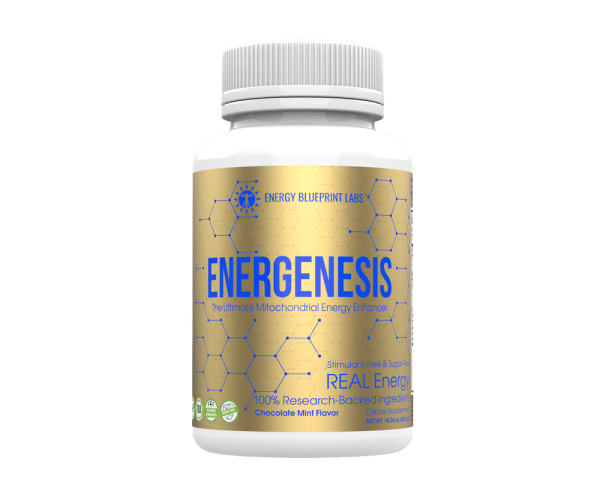
References
- Ciferri O. Spirulina, the edible microorganism. Microbiol Rev. 1983;47:551–78.
- Nawrocka D, Kornicka K, Śmieszek A, Marycz K. Spirulina platensis Improves Mitochondrial Function Impaired by Elevated Oxidative Stress in Adipose-Derived Mesenchymal Stromal Cells (ASCs) and Intestinal Epithelial Cells (IECs), and Enhances Insulin Sensitivity in Equine Metabolic Syndrome (EMS) Horses. Mar Drugs [Internet]. 2017;15. Available from: http://dx.doi.org/10.3390/md15080237
- Oriquat GA, Ali MA, Mahmoud SA, Eid RMHM, Hassan R, Kamel MA. Improving hepatic mitochondrial biogenesis as a postulated mechanism for the antidiabetic effect of Spirulina platensis in comparison with metformin. Appl Physiol Nutr Metab. 2019;44:357–64.
- Gao J, Zhao L, Wang J, Zhang L, Zhou D, Qu J, et al. C-Phycocyanin Ameliorates Mitochondrial Fission and Fusion Dynamics in Ischemic Cardiomyocyte Damage. Front Pharmacol. 2019;10:733.
- Liu Q, Huang Y, Zhang R, Cai T, Cai Y. Medical Application of Spirulina platensis Derived C-Phycocyanin. Evid Based Complement Alternat Med. 2016;2016:7803846.
- McCarty MF. Clinical potential of Spirulina as a source of phycocyanobilin. J Med Food. 2007;10:566–70.
- Olsson R, Stigendal L. Clinical experience with isolated hyperbilirubinemia. Scand J Gastroenterol. 1989;24:617–22.
- Horsfall LJ, Nazareth I, Pereira SP, Petersen I. Gilbert’s syndrome and the risk of death: a population-based cohort study. J Gastroenterol Hepatol. 2013;28:1643–7.
- Vítek L, Jirsa M, Brodanová M, Kalab M, Marecek Z, Danzig V, et al. Gilbert syndrome and ischemic heart disease: a protective effect of elevated bilirubin levels. Atherosclerosis. 2002;160:449–56.
- Lin J-P, O’Donnell CJ, Schwaiger JP, Cupples LA, Lingenhel A, Hunt SC, et al. Association between the UGT1A1*28 allele, bilirubin levels, and coronary heart disease in the Framingham Heart Study. Circulation. 2006;114:1476–81.
- Novotný L, Vítek L. Inverse relationship between serum bilirubin and atherosclerosis in men: a meta-analysis of published studies. Exp Biol Med . 2003;228:568–71.
- Cheriyath P, Gorrepati VS, Peters I, Nookala V, Murphy ME, Srouji N, et al. High Total Bilirubin as a Protective Factor for Diabetes Mellitus: An Analysis of NHANES Data From 1999 – 2006. J Clin Med Res. 2010;2:201–6.
- Bulmer AC, Blanchfield JT, Toth I, Fassett RG, Coombes JS. Improved resistance to serum oxidation in Gilbert’s syndrome: a mechanism for cardiovascular protection. Atherosclerosis. 2008;199:390–6.
- Copur B, Yilmaz N, Topcuoglu C, Kiziltunc E, Cetin M, Turhan T, et al. Relationship between elevated bilirubin level and subclinical atherosclerosis as well as oxidative stress in Gilbert syndrome. Gastroenterol Hepatol Bed Bench. 2020;13:133–40.
- Maruhashi T, Soga J, Fujimura N, Idei N, Mikami S, Iwamoto Y, et al. Hyperbilirubinemia, augmentation of endothelial function, and decrease in oxidative stress in Gilbert syndrome. Circulation. 2012;126:598–603.
- Tosevska A, Moelzer C, Wallner M, Janosec M, Schwarz U, Kern C, et al. Longer telomeres in chronic, moderate, unconjugated hyperbilirubinaemia: insights from a human study on Gilbert’s Syndrome. Sci Rep. 2016;6:22300.
- Gordon DM, Neifer KL, Hamoud A-RA, Hawk CF, Nestor-Kalinoski AL, Miruzzi SA, et al. Bilirubin remodels murine white adipose tissue by reshaping mitochondrial activity and the coregulator profile of peroxisome proliferator-activated receptor α. J Biol Chem. 2020;295:9804–22.
- Takei R, Inoue T, Sonoda N, Kohjima M, Okamoto M, Sakamoto R, et al. Bilirubin reduces visceral obesity and insulin resistance by suppression of inflammatory cytokines. PLoS One. 2019;14:e0223302.
- Liu J, Dong H, Zhang Y, Cao M, Song L, Pan Q, et al. Bilirubin Increases Insulin Sensitivity by Regulating Cholesterol Metabolism, Adipokines and PPARγ Levels. Sci Rep. 2015;5:9886.
- Jansen T, Daiber A. Direct Antioxidant Properties of Bilirubin and Biliverdin. Is there a Role for Biliverdin Reductase? Front Pharmacol. 2012;3:30.
- McDonagh AF. The biliverdin-bilirubin antioxidant cycle of cellular protection: Missing a wheel? Free Radic Biol Med. 2010;49:814–20.
- Inoguchi T, Sonoda N, Maeda Y. Bilirubin as an important physiological modulator of oxidative stress and chronic inflammation in metabolic syndrome and diabetes: a new aspect on old molecule. Diabetol Int. 2016;7:338–41.
- Kundur AR, Singh I, Bulmer AC. Bilirubin, platelet activation and heart disease: a missing link to cardiovascular protection in Gilbert’s syndrome? Atherosclerosis. 2015;239:73–84.
- DiNicolantonio JJ, McCarty MF, O’Keefe JH. Antioxidant bilirubin works in multiple ways to reduce risk for obesity and its health complications. Open Heart. 2018;5:e000914.
- Hinds TD Jr, Stec DE. Bilirubin, a Cardiometabolic Signaling Molecule. Hypertension. 2018;72:788–95.
- Panday A, Sahoo MK, Osorio D, Batra S. NADPH oxidases: an overview from structure to innate immunity-associated pathologies. Cell Mol Immunol. 2015;12:5–23.
- Bedard K, Krause K-H. The NOX family of ROS-generating NADPH oxidases: physiology and pathophysiology. Physiol Rev. 2007;87:245–313.
- Huang H, Liao D, Pu R, Cui Y. Quantifying the effects of spirulina supplementation on plasma lipid and glucose concentrations, body weight, and blood pressure. Diabetes Metab Syndr Obes. 2018;11:729–42.
- Marston NA, Giugliano RP, Im K, Silverman MG, O’Donoghue ML, Wiviott SD, et al. Association Between Triglyceride Lowering and Reduction of Cardiovascular Risk Across Multiple Lipid-Lowering Therapeutic Classes: A Systematic Review and Meta-Regression Analysis of Randomized Controlled Trials. Circulation. 2019;140:1308–17.
- Serban M-C, Sahebkar A, Dragan S, Stoichescu-Hogea G, Ursoniu S, Andrica F, et al. A systematic review and meta-analysis of the impact of Spirulina supplementation on plasma lipid concentrations. Clin Nutr. 2016;35:842–51.
- Yousefi R, Saidpour A, Mottaghi A. The effects of Spirulina supplementation on metabolic syndrome components, its liver manifestation and related inflammatory markers: A systematic review. Complement Ther Med. 2019;42:137–44.
- Bobescu E, Bălan A, Moga MA, Teodorescu A, Mitrică M, Dima L. Are There Any Beneficial Effects of Spirulina Supplementation for Metabolic Syndrome Components in Postmenopausal Women? Mar Drugs [Internet]. 2020;18. Available from: http://dx.doi.org/10.3390
- Parikh P, Mani U, Iyer U. Role of Spirulina in the Control of Glycemia and Lipidemia in Type 2 Diabetes Mellitus. J Med Food. 2001;4:193–9.
- Szulinska M, Gibas-Dorna M, Miller-Kasprzak E, Suliburska J, Miczke A, Walczak-Gałezewska M, et al. Spirulina maxima improves insulin sensitivity, lipid profile, and total antioxidant status in obese patients with well-treated hypertension: a randomized double-blind placebo-controlled study. Eur Rev Med Pharmacol Sci. 2017;21:2473–81.
- Ismail M, Hossain MF, Tanu AR, Shekhar HU. Effect of spirulina intervention on oxidative stress, antioxidant status, and lipid profile in chronic obstructive pulmonary disease patients. Biomed Res Int. 2015;2015:486120.
- Mitra S, De A, Chowdhury A. Epidemiology of non-alcoholic and alcoholic fatty liver diseases. Transl Gastroenterol Hepatol. 2020;5:16.
- Mazokopakis EE, Papadomanolaki MG, Fousteris AA, Kotsiris DA, Lampadakis IM, Ganotakis ES. The hepatoprotective and hypolipidemic effects of Spirulina (Arthrospira platensis) supplementation in a Cretan population with non-alcoholic fatty liver disease: a prospective pilot study. Ann Gastroenterol Hepatol . 2014;27:387–94.
- Ferreira-Hermosillo A, Torres-Duran PV, Juarez-Oropeza MA. Hepatoprotective effects of Spirulina maxima in patients with non-alcoholic fatty liver disease: a case series. J Med Case Rep. 2010;4:103.
- Kalafati M, Jamurtas AZ, Nikolaidis MG, Paschalis V, Theodorou AA, Sakellariou GK, et al. Ergogenic and antioxidant effects of spirulina supplementation in humans. Med Sci Sports Exerc. 2010;42:142–51.
- Lu H-K, Hsieh C-C, Hsu J-J, Yang Y-K, Chou H-N. Preventive effects of Spirulina platensis on skeletal muscle damage under exercise-induced oxidative stress. Eur J Appl Physiol. 2006;98:220–6.
- Johnson M, Hassinger L, Davis J, Devor ST, DiSilvestro RA. A randomized, double blind, placebo controlled study of spirulina supplementation on indices of mental and physical fatigue in men. Int J Food Sci Nutr. 2016;67:203–6.
- Hernández-Lepe MA, López-Díaz JA, Juárez-Oropeza MA, Hernández-Torres RP, Wall-Medrano A, Ramos-Jiménez A. Effect of Arthrospira (Spirulina) maxima Supplementation and a Systematic Physical Exercise Program on the Body Composition and Cardiorespiratory Fitness of Overweight or Obese Subjects: A Double-Blind, Randomized, and Crossover Controlled Trial. Mar Drugs [Internet]. 2018;16. Available from: http://dx.doi.org/10.3390/md16100364
- Hernández-Lepe MA, Olivas-Aguirre FJ, Gómez-Miranda LM, Hernández-Torres RP, Manríquez-Torres J de J, Ramos-Jiménez A. Systematic Physical Exercise and Spirulina maxima Supplementation Improve Body Composition, Cardiorespiratory Fitness, and Blood Lipid Profile: Correlations of a Randomized Double-Blind Controlled Trial. Antioxidants (Basel) [Internet]. 2019;8. Available from: http://dx.doi.org/10.3390/antiox8110507
- Jensen GS, Drapeau C, Lenninger M, Benson KF. Clinical Safety of a High Dose of Phycocyanin-Enriched Aqueous Extract from Arthrospira (Spirulina) platensis: Results from a Randomized, Double-Blind, Placebo-Controlled Study with a Focus on Anticoagulant Activity and Platelet Activation. J Med Food. 2016;19:645–53.
- Cingi C, Conk-Dalay M, Cakli H, Bal C. The effects of spirulina on allergic rhinitis. Eur Arch Otorhinolaryngol. 2008;265:1219–23.
- Saha SK, Misbahuddin M, Khatun R, Mamun IR. Effect of hexane extract of spirulina in the removal of arsenic from isolated liver tissues of rat. Mymensingh Med J. 2005;14:191–5.
- Saha SK, Misbahuddin M, Ahmed AU. Comparison between the effects of alcohol and hexane extract of spirulina in arsenic removal from isolated tissues. Mymensingh Med J. 2010;19:27–31.
- Misbahuddin M, Islam AZMM, Khandker S, Ifthaker-Al-Mahmud, Islam N, Anjumanara. Efficacy of spirulina extract plus zinc in patients of chronic arsenic poisoning: a randomized placebo-controlled study. Clin Toxicol . 2006;44:135–41.




